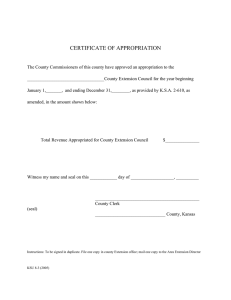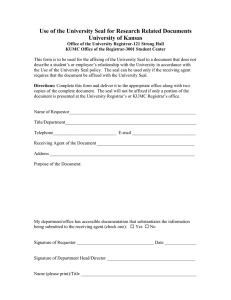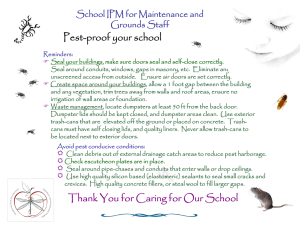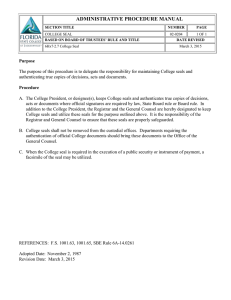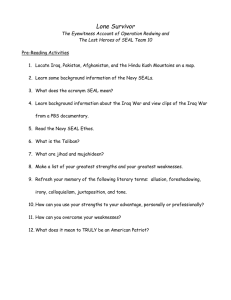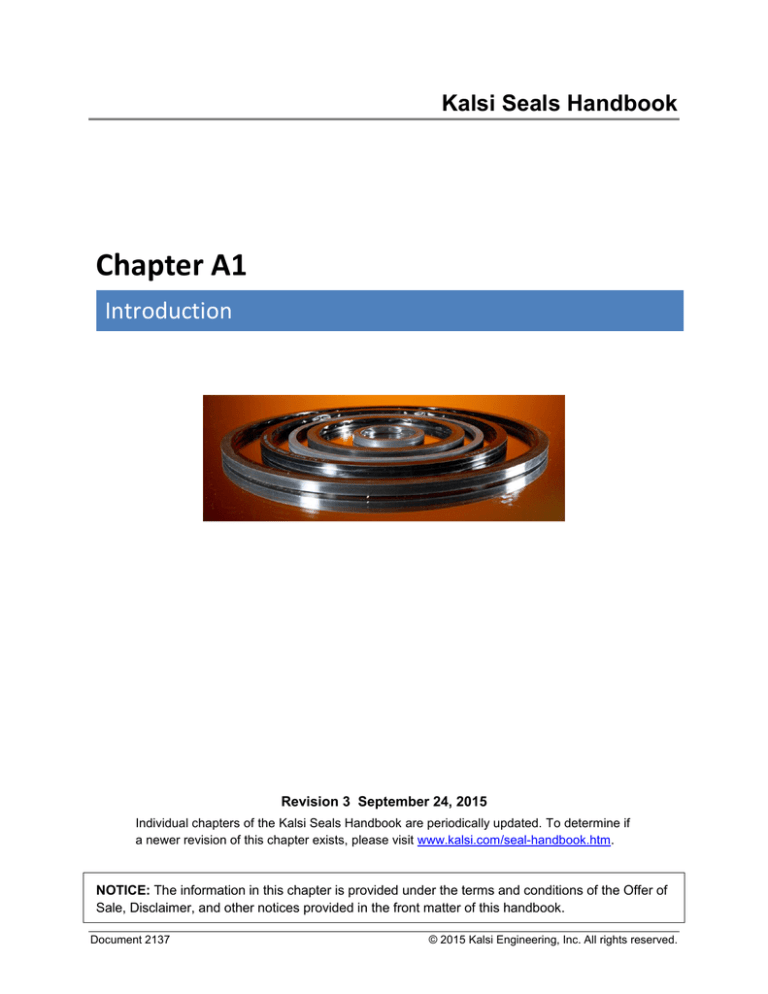
Kalsi Seals Handbook
Chapter A1
Introduction
Revision 3 September 24, 2015
Individual chapters of the Kalsi Seals Handbook are periodically updated. To determine if
a newer revision of this chapter exists, please visit www.kalsi.com/seal-handbook.htm.
NOTICE: The information in this chapter is provided under the terms and conditions of the Offer of
Sale, Disclaimer, and other notices provided in the front matter of this handbook.
Document 2137
© 2015 Kalsi Engineering, Inc. All rights reserved.
Introduction
1.
Chapter A1 Page 1
Purpose and basis of this handbook
Kalsi Seals® are typically used in relatively complex rotating machinery that is exposed
to harsh conditions. In order to achieve maximum rotary seal performance, a systems
approach is required for machine design. Any number of factors can influence seal
performance, such as bearing implementation, heat transfer efficiency, shaft surface
finish, reversing pressure conditions, shaft vibration and deflection, assembly techniques,
differential pressure, extrusion gap clearance, pressure compensation, lubricant selection,
threaded connection alignment, and chemical exposure – and more.
One thing that sets Kalsi Engineering apart from other seal companies is our ability to
draw upon decades of seal testing and mechanical design experience to support customer
applications. We wrote this rotary seal handbook to help our customers benefit from our
experiences, with the desire that they may obtain the best possible seal performance. The
knowledge in this handbook is the result of seal-related research and development
projects that were funded by Kalsi Engineering and, in some cases, the United States
Department of Energy. Our projects have included the design, analysis and field testing
of surface and downhole research tools that were developed to provide Kalsi Engineering
with direct feedback on seal and hardware performance. Figure 1 illustrates one such
research tool, a sealed bearing mud motor assembly.
Figure 1
Dr. Kalsi inspects a sealed bearing mud motor that Kalsi Engineering designed and
manufactured as a research tool, to obtain firsthand information about downhole seal
performance.
Contact Kalsi Engineering
Search this handbook
Introduction
2.
Chapter A1 Page 2
What are Kalsi Seals?
Kalsi Seals are a family of rotary shaft seals for contaminant exclusion and lubricant
retention in harsh service conditions such as environmental abrasives, high differential
pressures, and high levels of shock and vibration. The seals are compact precisionmolded polymeric rings. They incorporate proprietary features that dramatically improve
seal and shaft life through hydrodynamic lubrication, providing economic and
performance benefits that surpass many other types of rotary seals. Figure 2 shows the
geometry of a representative Kalsi Seal. Kalsi Engineering’s rotary seal product line was
established to address the harsh and unforgiving conditions of the oilfield downhole
environment. Kalsi Seals are available in a wide range of sizes, designs, and materials to
satisfy a variety of application requirements.
Figure 2
The dynamic sealing lip of a Kalsi Seal has waves that produce hydrodynamic lubrication,
allowing the seal to operate at much higher pressure and speed combinations than
conventional rotary seals. Several different seal configurations are available.
Typical applications include both low and high pressure installations, such as:
Downhole drilling mud motors
Construction swivels
Rotary steerable drilling tools
Oilfield vacuum truck agitators
High speed coring swivels
Industrial slurry mixers
Rotary Control Devices (RCD's)
Roller reamers
Rotary valve actuators
Machine tools
Rock drilling machines
Hydraulic swivels
Slant hole drilling swivels
Blasthole drilling
Underwater vehicles
Gun drills
Submerged dredge pumps
Side port swivels
Oilfield cement pumps
Contact Kalsi Engineering
Search this handbook
Introduction
3.
Chapter A1 Page 3
Kalsi Seal principle of operation
The Kalsi Seal™ is installed in a circular housing gland (Figure 3) that compresses it
against the shaft, eliminating clearance and establishing static sealing in the same manner
as other interference-type seals, such as O-rings. When the shaft rotates, the seal remains
stationary and the seal-to-shaft interface becomes dynamic.
The dynamic sealing lip has a wavy shape on its lubricant side, and an abrupt circular
exclusionary shape on its environment side. This unique geometry dramatically improves
seal life by lubricating the dynamic seal-to-shaft interface while excluding environmental
contaminates.
Figure 3
The unique geometry of the Kalsi Seal wedges a hydrodynamic
film into the dynamic seal to shaft interface during rotation to
reduce friction and wear while excluding abrasives.
As rotation occurs, the rotational velocity of the shaft drags a thin lubricant film past the
wavy edge and into the dynamic sealing interface (Figure 3). This hydroplaning effect
lubricates the seal and shaft surfaces, and prevents the typical dry rubbing wear and high
friction associated with conventional rubber (Figure 4) and plastic seals. This prolongs
Contact Kalsi Engineering
Search this handbook
Introduction
Chapter A1 Page 4
seal and shaft surface life, and makes operating at higher speed and pressure practical.
For a slow motion animation of Kalsi Seal lubrication, visit our website.
The hydrodynamic wedging action causes a controlled hydrodynamic pumping related
lubricant leakage rate during rotation. When rotation stops, the hydrodynamic action
stops, and a static sealing relationship is reestablished due to the initial compression of
the seal. The interfacial lubricant film thickness decays gradually when rotation stops,
due to squeeze film effect.
Hydrodynamic leakage and film thickness during rotation are dependent upon a number
of factors, including rotary speed, lubricant viscosity, differential pressure, hardware
design, and seal geometry.
The leakage of most types of Kalsi Seals is minute, being in about the same range as
typical mechanical face seal leakage. Certain types of Kalsi Seals, such as the Enhanced
Lubrication Seal, are designed to provide increased hydrodynamic leakage for those
applications where such performance is desirable. Regardless of which type of Kalsi Seal
is employed, a suitably sized lubricant reservoir must be provided to accommodate the
hydrodynamic pumping related leakage (Chapter D11).
Figure 4
Conventional seals, such as this O-ring, suffer from heat and
wear damage if rotated with significant differential pressure.
4.
Kalsi Seal product overview
The Kalsi Seal product line consists of a number of rotary shaft seal styles that address a
variety of sealing challenges. Custom cross-sectional sizes can be engineered for unique
applications, and specific features can be tailored to the application if necessary.
Contact Kalsi Engineering
Search this handbook
Introduction
Chapter A1 Page 5
Kalsi Seal Product Overview
Wide Footprint Seal – An improved product intended for direct interchange
with Standard Kalsi Seals, to achieve longer life in pressurized lubricant
applications. The improved geometry provides increased abrasive exclusion
and additional sacrificial material to accommodate wear.
Axially Constrained Seal – Developed for excluding abrasives in nonpressurized applications, and in applications with low levels of reversing
pressure. Also useful for retaining pressurized lubricants up to approximately
750 psi. This geometry does not require spring loading in any situation.
Composite High Temperature construction – Exploits the latest FEPM/FKM
polymer technology for low to medium pressure lubricant retention and
abrasive exclusion in high temperature environments.
Standard Kalsi Seal –A general-purpose hydrodynamic seal for pressurized
lubricant retention and abrasive exclusion that is used in a variety of low to
high differential pressure applications. It can also be used to retain nonpressurized lubricants if axially spring loaded.
Enhanced Lubrication Seal – An aggressive hydrodynamic wave geometry
that provides enhanced lubrication. Particularly useful when thin viscosity
lubricants, high temperatures, poor heat transfer conditions, or high differential
pressures are encountered. Compared to Standard and Wide Footprint Kalsi
Seals, an Enhanced Lubrication Seal™ allows significantly higher speeds in
low differential pressure conditions with thin viscosity lubricants. Enhanced
lubrication seals are available with single and dual durometerDurometer
construction, and in various lip widths.
Chamfered Enhanced Lubrication Seal - A subset of Enhanced Lubrication
Seals. They were designed for applications where the pressure of an abrasive
environment is higher than the pressure of the seal lubricant. Kalsi Engineering
refers to this condition as “reverse pressure”. This breakthrough allows the seal
to be used in equipment that has a simple gravity fed lubricant reservoir.
Hybrid Seal – Hybrid seals mix enhanced lubrication waves with more
conventional waves to temper the hydrodynamic pumping-related leak rate
while still providing a torque advantage over Standard seals. Hybrid seals were
developed to provide reduced running torque and seal generated heat in oilfield
tools, and are also useful in a variety of other applications.
Plastic Lined Seal – A seal directed at increased high different pressure
sealing capacity and reducing breakout torque. This geometry has a plastic
layer at the dynamic interface, and an elastomer energizing section forming the
seal body. The use of a plastic liner allows high pressure extrusion resistance
and has a lower coefficient of friction thereby reducing breakout torque
compared to elastomer only Kalsi Seals.
Dual Durometer construction – A seal for pressurized lubricant retention that
employs dual hardness construction to reduce interfacial contact pressure, and
allowing a hard extrusion resistant compound to be used at the dynamic sealing
lip. Depending on compound selection, it can be configured to seal higher
pressures than a Standard seal, or run at lower torque and higher speeds. It
provides good abrasion resistance when differential pressure is maintained.
Contact Kalsi Engineering
Search this handbook
Introduction
Chapter A1 Page 6
High Film Seal – A special purpose seal that incorporates an extremely
aggressive unidirectional hydrodynamic geometry for pressurized lubricant
retention and abrasive exclusion in applications that can tolerate or exploit a
very high hydrodynamic pumping rate. It can lubricate with fluids as thin as
water.
Filled Seal – A more economical dual material seal design for high speed
pressurized lubricant retention. Permits higher speeds than conventional Dual
Durometer Seals. Not recommended for abrasive applications. When combined
with the enhanced lubrication wave pattern, leakage and torque are similar to a
solid cross-section High Film seal, but in a bi-directional rotation design.
Grooved Seal – A special purpose seal that incorporates a flexing lip for
reduced torque in medium differential pressure applications. Not recommended
for abrasive exclusion, or very high or low differential pressures.
In general, the larger seal cross-sections are preferred whenever sufficient space is
available. For a given amount of percentage compression, a larger cross-section has more
dimensional compression, is more tolerant of variations in gland depth, and less prone to
slippage. For a given amount of dimensional compression, a larger cross-section has a
lower percentage of compression, which reduces interfacial contact pressure and sealgenerated heat.
5.
Kalsi Engineering company background
Kalsi Engineering, Inc. was founded in 1978 to provide consulting engineering services
in the areas of research and development, design, analysis, and testing of mechanical
equipment and structures. The company facilities (Figure 5) are located in the Houston,
Texas metropolitan area. The founder and President of the company, M. S. Kalsi, PhD,
P.E. was the director of research and development for a well-known valve manufacturer
prior to starting Kalsi Engineering. He became interested in the field of
elastohydrodynamic lubrication while pursuing his masters and doctorate degrees. His
fundamental research led to the basic lubrication concept employed by the Kalsi Seal
product line. The company's pioneering efforts and commitment to continued research
and development have resulted in a variety of rotary seal products that extend the
performance envelope well beyond the original design. Performance has been verified by
years of laboratory and field tests and commercial use.
Contact Kalsi Engineering
Search this handbook
Introduction
Chapter A1 Page 7
Figure 5
Kalsi Engineering, Inc. is located in the Houston, Texas metropolitan area
Kalsi Engineering's facilities are located in Sugar Land, Texas, and house our consulting
engineering offices, mechanical testing laboratories, flow loop, and Kalsi Seal operations.
Our highly experienced staff of mechanical engineers has a variety of complementary
skills and industry backgrounds. We are well versed in classical solid mechanics/stress
analysis and thermo-fluid analysis. Kalsi Engineering uses state of the art design,
analysis and testing software to support our activities.
6.
Continuing seal research and development
Our research and development mission is continual product improvement directed at the
needs of new and existing rotary seal markets. Products are developed and refined using
state-of-the-art analysis techniques and rigorous testing. The performance of existing
products is continually evaluated in our well-equipped seal testing laboratory (Figures 6
and 7),
Contact Kalsi Engineering
Search this handbook
Introduction
Chapter A1 Page 8
Figure 6
Kalsi Engineering has an experienced team of engineers, analysts, and technicians who
are committed to rotary seal research, development, and testing.
Figure 7
Computer-controlled rotary test fixtures are available to evaluate seal performance with
customer-specified lubricants, process fluids, temperatures and other application-specific
conditions. The fixtures are color coded for reference purposes. That is our seal testing
team in the foreground.
Contact Kalsi Engineering
Search this handbook
Introduction
7.
Chapter A1 Page 9
Consulting engineering capabilities
The Kalsi Engineering staff has an outstanding and diverse engineering background, with
a record of accomplishments in developing practical and cost effective solutions to
mechanical engineering problems in a wide range of applications in the power
generation, oilfield, petrochemical, aerospace, defense, manufacturing and mining
industries. The company’s core capabilities include structural, fluid and thermal analysis,
mechanical design and product development, tribology, and testing.
Kalsi Engineering is recognized worldwide for technical excellence. Our numerous
industry milestones, guidelines, technical publications, new products, and patents
continue to provide long-term benefits to our clients and to the industries we serve. Visit
our web site at www.kalsi.com for additional information.
Contact Kalsi Engineering
Search this handbook

